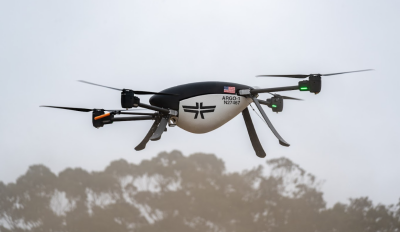On the latest edition of The Drone Radio Show podcast, host Randy Goers, interviewed Jeremiah Karpowicz, Executive Editor of Commercial UAV News to dig a little deeper on his Commercial Drone Predictions for 2018 report. For the past three years Jeremiah has been publishing this yearly window into the future of the UAV technology and, according to the report, in 2018 the market as a whole will be more focused on the use and application of data gathered by drones, rather than specifically how that data is acquired.
 In 2016 it was all about the drone, but 2017 brought a dramatic shift when it comes to the collection and processing of large amounts of data. The phrase, "it's not the drone, it's the data" is one that has been especially prevalent of late. Additionally, the 2018 report also details trends that will impact the worldwide drone market, as opposed to previous years when Europe and the U.S. were analyzed as having separate trends. The full implementation of Part 107 that we saw take place in the U.S. has allowed the United States to catch up and in some ways even surpass the regulatory landscape that exists throughout Europe.When asked about the two drone events organized by Commercial UAV Expo, Jeremiah explained that Commercial UAV Expo Americas and Commercial UAV Europe are distinct, each is solely focused on where and show the technology is being used in a variety of industries, including surveying & mapping, construction, emergency response, and plenty more. This industrial focus is what differentiates both Commercial UAV Expos from other events and attracts professionals from these industries who are integrating or operating drones.Jeremiah also talked about the lessons that companies have learned over the past three years when it comes to adding UAV technology to their daily operations. New players are deciding between creating drone programs from scratch, acquiring small companies and adapting them to their particular needs or hiring third-party service providers. All three approaches are seen as having pros and cons and companies are spending more time analyzing them as opposed to simply buying a drone.A key element of the report are the predictions for the year to come and Jeremiah highlighted four areas that will receive a lot of attention in 2018:Counter Drone Technology: This particular market niche is evolving in many different ways but regulation and enforcement will be the key elements to look for.Unmanned Traffic Management (UTM): This technology will see tremendous advancement in 2018 with efforts fro individual states, NASA and the private sector.High Altitude/Long Endurance (HALE): As applications require more than just 25 minutes to be commercially viable, HALE systems offer days and weeks of aloft.Automation: The development of something like a "drone in a box" is going to be inherently separate and different from the regulation that will allow organizations to deploy this technology.Jeremiah emphasized the need for commercial operators to create value with their drone programs by making an active attempt to define what value means from them, which might be completely different for each company. Some might define it as a function of savings in day-to-day operations while others might increase the safety of their field crews or increased productivity. Defining measurable and intangible value propositions for drones in utilities is something San Diego Gas & Electric went through, and those results are serving the company in the present and future.However individuals or organization define creating value with their drone, 2018 is set to be the year when organizations across the world explore this concept in critical detail. Doing so will create opportunities related to automation, counter drone technology and plenty more this year and beyond.
In 2016 it was all about the drone, but 2017 brought a dramatic shift when it comes to the collection and processing of large amounts of data. The phrase, "it's not the drone, it's the data" is one that has been especially prevalent of late. Additionally, the 2018 report also details trends that will impact the worldwide drone market, as opposed to previous years when Europe and the U.S. were analyzed as having separate trends. The full implementation of Part 107 that we saw take place in the U.S. has allowed the United States to catch up and in some ways even surpass the regulatory landscape that exists throughout Europe.When asked about the two drone events organized by Commercial UAV Expo, Jeremiah explained that Commercial UAV Expo Americas and Commercial UAV Europe are distinct, each is solely focused on where and show the technology is being used in a variety of industries, including surveying & mapping, construction, emergency response, and plenty more. This industrial focus is what differentiates both Commercial UAV Expos from other events and attracts professionals from these industries who are integrating or operating drones.Jeremiah also talked about the lessons that companies have learned over the past three years when it comes to adding UAV technology to their daily operations. New players are deciding between creating drone programs from scratch, acquiring small companies and adapting them to their particular needs or hiring third-party service providers. All three approaches are seen as having pros and cons and companies are spending more time analyzing them as opposed to simply buying a drone.A key element of the report are the predictions for the year to come and Jeremiah highlighted four areas that will receive a lot of attention in 2018:Counter Drone Technology: This particular market niche is evolving in many different ways but regulation and enforcement will be the key elements to look for.Unmanned Traffic Management (UTM): This technology will see tremendous advancement in 2018 with efforts fro individual states, NASA and the private sector.High Altitude/Long Endurance (HALE): As applications require more than just 25 minutes to be commercially viable, HALE systems offer days and weeks of aloft.Automation: The development of something like a "drone in a box" is going to be inherently separate and different from the regulation that will allow organizations to deploy this technology.Jeremiah emphasized the need for commercial operators to create value with their drone programs by making an active attempt to define what value means from them, which might be completely different for each company. Some might define it as a function of savings in day-to-day operations while others might increase the safety of their field crews or increased productivity. Defining measurable and intangible value propositions for drones in utilities is something San Diego Gas & Electric went through, and those results are serving the company in the present and future.However individuals or organization define creating value with their drone, 2018 is set to be the year when organizations across the world explore this concept in critical detail. Doing so will create opportunities related to automation, counter drone technology and plenty more this year and beyond. 














Comments